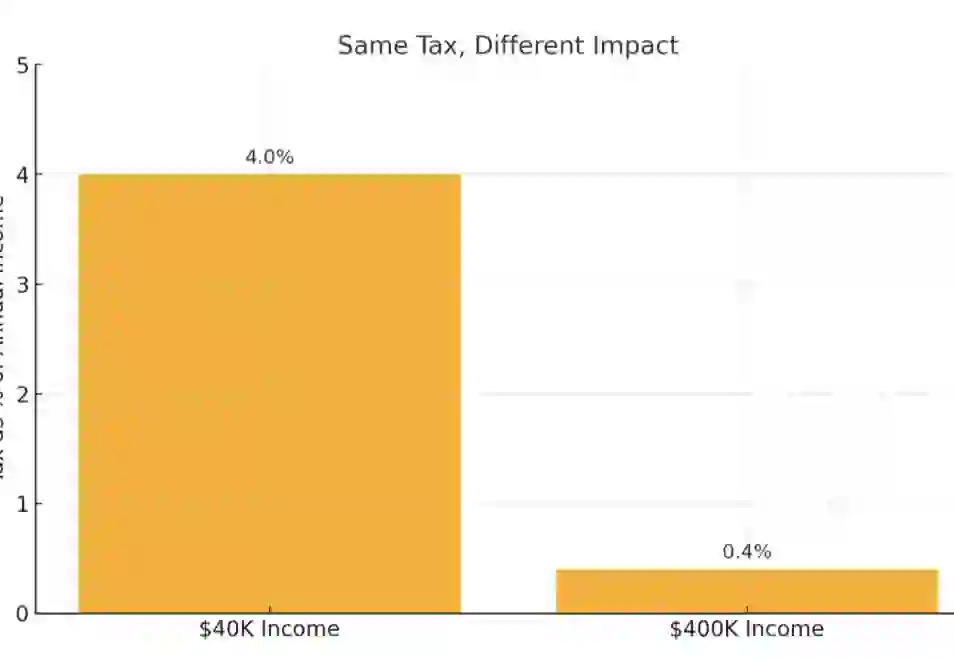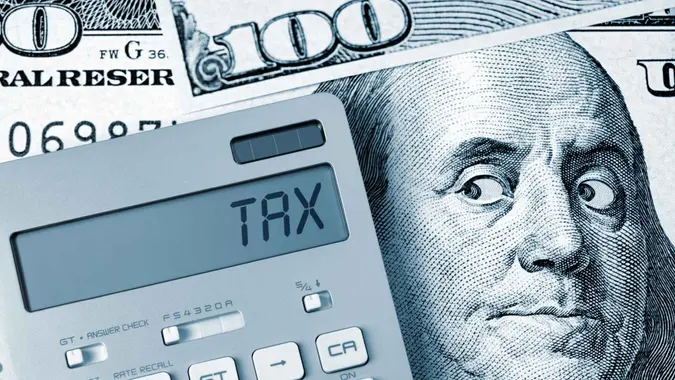Regressive Tax Explained: What You Should Know

Commitment to Our Readers
GOBankingRates' editorial team is committed to bringing you unbiased reviews and information. We use data-driven methodologies to evaluate financial products and services - our reviews and ratings are not influenced by advertisers. You can read more about our editorial guidelines and our products and services review methodology.

20 Years
Helping You Live Richer

Reviewed
by Experts

Trusted by
Millions of Readers
Ever wondered why sales tax hits harder when your budget is tight? That’s the effect of a regressive tax — a type of tax that takes a bigger bite out of your income the less you make.
If you’ve ever felt like your paycheck doesn’t stretch as far as it should — especially when covering everyday costs like gas or groceries — you might already be paying more in taxes than someone who earns double your income.
This article explains a regressive tax, why it matters and how it impacts people differently depending on their income.
What Is a Regressive Tax?
A regressive tax is a tax that takes a larger percentage of income from low-income earners than from high-income earners.
Unlike progressive taxes — where tax rates increase with income — regressive taxes apply the same rate to everyone, regardless of income level.
Common Examples:
- Sales tax on groceries or clothing
- Gas tax at the pump
- Toll roads or flat fees
- Excise taxes on cigarettes or alcohol
These taxes are considered regressive because they don’t adjust based on a person’s ability to pay. If you make $30,000 a year and pay $600 in sales tax, that’s 2% of your income. But for someone making $300,000, that same $600 is just 0.2%.
How Regressive Taxes Are Structured
Regressive taxes charge the same tax rate to everyone — regardless of income level. That means someone earning $40,000 per year pays the same tax rate as someone earning $400,000.
These taxes are typically applied as a fixed percentage or a flat fee. Sales tax, for instance, is usually a set rate — say, 6% — added to most purchases.
Whether you’re buying a $5 sandwich or a $500 television, the rate stays the same no matter how much you earn. (Many states don’t charge sales tax on groceries, but a handful of them do.)
Flat fees, like toll roads or vehicle registration costs, also fall into this category. Since the dollar amount is the same for everyone, these charges hit lower earners harder relative to their income.
Unlike progressive taxes, which vary depending on your income bracket (like federal income tax), regressive taxes remain static, making them feel less equitable in practice.
How Regressive Taxes Impact Different Income Groups
Although regressive taxes charge all individuals the same tax rate, they don’t affect all income groups equally.
While a flat tax structure may seem like a fair way to impose a tax, it puts a heavier burden on low-income households, since they spend more of their income on these costs.
High-income earners, by contrast, pay the same amount in dollars, but it represents a much smaller percentage of their income, making it far less noticeable in their overall budget.
The key issue with regressive taxes is how they affect people in proportion to what they earn. Here’s a simplified look:
| Income Level | Annual Income | Tax Paid | Tax as % of Income |
|---|---|---|---|
| Low-income worker | $25,000 | $750 | 3% |
| Middle-income earner | $60,000 | $900 | 1.5% |
| High-income earner | $250,000 | $1,000 | 0.4% |
As income rises, the effective burden of the tax drops.
Even though both buyers pay the same amount in tax, the financial impact is ten times heavier on the lower-income household.

This imbalance may affect certain demographics especially hard, including:
- Renters who don’t benefit from home equity or property tax deductions.
- Seniors living on a fixed income.
- People with disabilities or chronic illnesses with limited earning capacity.
Because these groups spend more of their income on everyday necessities, regressive taxes could cause more financial strain if they’re already living paycheck to paycheck.
What is an Example of a Regressive Tax?
Here’s a quick list of regressive taxes you might encounter regularly:
- Sales tax – Paid on most goods, sometimes even on essentials like clothing and school supplies.
- Gas tax – Included in every gallon you buy, regardless of your income.
- Payroll tax – Social Security tax applies only up to a certain income cap.
- Sin taxes – On alcohol, cigarettes, and lottery tickets.
- Toll roads and flat fees – Charged the same for everyone, regardless of income.
Let’s look closer at a few of these:
Sales Tax
Sales and local taxes typically charge the same rate to everyone, regardless of income or economic status. Essential items, such as food and clothing, may be exempt from sales tax, but that exemption is available to everyone.
The argument could be made that wealthier people buy more things, and therefore pay a larger share of the total amount of sales tax. While that’s generally true, a sales tax is still regressive, since it levies the same amount of tax on each item purchased, regardless of the income level of the purchaser.
Gas Taxes
Gas taxes are also regressive because the same dollar amount of tax is charged on every gallon of gasoline, regardless of who purchases it. This can be more burdensome on lower earners, especially since many people need gas to drive to work.
Payroll Taxes
Payroll taxes are considered regressive because the same percentage is applied to all wage earners. While employers typically pay half the cost, employees still pay a flat rate that doesn’t scale with income.
In 2025, the employee share of payroll taxes includes:
- 6.2% for Social Security (on wages up to $176,100)
- 1.45% for Medicare (on all wages)
- + 0.9% Medicare surtax on wages above $200,000
- Total: 7.65%, with employers matching this amount
Because only the first $176,100 of wages is subject to Social Security tax, high earners end up paying an even smaller percentage of their income toward this tax. And while those earning over $200,000 pay an additional 0.9% Medicare surtax, it doesn’t fully offset the benefit they receive from the Social Security cap.
As a result, lower earners pay payroll taxes on nearly all of their income, while high earners pay them on only a portion.
| Tax Type | Employee Rate | Employer Match | Taxable Income Cap |
|---|---|---|---|
| Social Security | 6.2% | 6.2% | $176,100 |
| Medicare | 1.45% | 1.45% | No cap |
| Medicare surtax | 0.9% | None; employee only | Income above $200,000 |
| Total (typically) | 7.65% | 7.65% | Varies based on earnings |
Sin Taxes
Sin taxes are extra charges on certain products and activities that the government wants to discourage. Common examples include:
- Cigarettes
- Alcohol
- Sugary drinks
- Gambling or lottery winnings
Because these are taxed at a flat rate, sin taxes are also considered regressive. However, governments still use them to reduce harmful behaviors and raise revenue for public services.
The big concern, though, is fairness. People in poverty are more likely to experience gambling problems. And while lower-income households may spend less on alcohol and tobacco, those expenses eat up a larger share of their income compared to wealthier households.
Some Income Taxes
Some states and municipalities have a flat income tax, meaning everyone pays the same percentage of their income, no matter what they earn.
While this type of tax is technically proportional, critics argue it has regressive effects. Since it doesn’t adjust based on the taxpayer’s ability to pay, it could place a heavier burden on low-income households.
Pros and Cons of Regressive Taxes
Below is a quick overview of the benefits and drawbacks of regressive taxes.
| Pros | Cons |
|---|---|
| Simple and easy to collect | Disproportionately affects low-income households |
| Provides steady revenue for governments | Can worsen income inequality |
| Applies to everyone equally (on paper) | Doesn’t account for the ability to pay |
Regressive vs. Progressive Taxes
While regressive taxes charge the same rate for everyone, progressive taxes increase the tax rate as a person’s income rises. That means higher-income households pay a larger percentage of their income in taxes, while lower-income households pay a smaller percentage.
The federal income tax in the United States is a progressive tax system, which means you move into a higher tax bracket as your income increases. However, only the income within each bracket is taxed at that bracket’s rate, not your entire income.
To understand the difference, here’s a side-by-side comparison:
| Tax Type | How It Works | Example |
|---|---|---|
| Regressive | Everyone pays the same rate or amount | Sales tax, gas tax |
| Progressive | Higher earners pay a higher tax rate | Federal income tax |
| Proportional | Everyone pays the same percentage of income | Flat state income taxes (e.g., Utah, Indiana) |
Federal income tax is progressive, while most state-level sales taxes are regressive.
Alternatives to Regressive Taxes
There are two main alternatives to regressive taxes: progressive and proportional taxes. Both try to distribute the tax burden more equally but operate differently.
Progressive Taxes
Progressive taxes increase the tax rate as your income rises. That means higher-income households pay more (as a percentage of income) in taxes, and lower-income households pay less.
- Example: U.S. federal income tax
Proportional Taxes
Proportional taxes (sometimes called flat income taxes) charge the same income tax across all income groups. So, the more money you make, the more you’ll pay in taxes.
- Example: State flat income taxes, like in Indiana, Michigan and Utah
How Different Tax Types Affect Income Groups
| Income Level | Annual Income | Tax Paid (Example) | Effective Tax Rate (Regressive) | Effective Tax Rate (Proportional) | Effective Tax Rate (Progressive) |
|---|---|---|---|---|---|
| Low-income earner | $25,000 | $1,000 | 4% | 4% | 2% |
| Middle-income earner | $60,000 | $1,800 | 3% | 3% | 8% |
| High-income earner | $250,000 | $2,000 | 0.8% | 0.8% | 18% |
Key Takeaway: Under a regressive tax, lower-income earners shoulder a larger tax burden proportionally. Progressive taxes are structured to reduce that imbalance, while proportional taxes apply the same rate across all income levels.
Final Take to GO: Why Regressive Taxes Matter
Understanding how a regressive tax works can help you see why some taxes feel heavier than others — especially if you’re working with a tight budget.
Whether it’s the sales tax on school supplies or the gas tax that adds up with every commute, these taxes take a toll on lower- and middle-income earners in ways that wealthier households might barely notice.
If you’re trying to budget smarter or get involved in local policy conversations, knowing the difference between regressive, progressive and proportional taxes puts you one step ahead.
FAQs About Regressive Tax
Here are some common questions and concerns about the in's and out's of regressive tax:- What is a regressive tax on income?
- Technically, most regressive taxes aren’t levied on income directly. But when taxes like sales or gas taxes eat up more of your paycheck than someone else's, it acts like a regressive tax on income.
- Is sales tax a regressive tax?
- Yes. Sales tax is a prime example of a regressive tax because everyone pays the same rate regardless of income.
- Why are regressive taxes controversial?
- They disproportionately affect low-income households, raising questions about fairness and economic inequality.
- Are there any benefits to regressive taxes?
- They’re easy to administer and generate consistent revenue, which helps fund services like roads and schools. But they’re rarely equitable.
- Do regressive taxes exist at the federal level?
- Most federal taxes are progressive (like income tax), but payroll taxes -- which fund Social Security and Medicare -- have regressive elements due to wage caps.
Information is accurate as of May 14, 2025.
Editorial Note: This content is not provided by any entity covered in this article. Any opinions, analyses, reviews, ratings or recommendations expressed in this article are those of the author alone and have not been reviewed, approved or otherwise endorsed by any entity named in this article.
Our in-house research team and on-site financial experts work together to create content that’s accurate, impartial, and up to date. We fact-check every single statistic, quote and fact using trusted primary resources to make sure the information we provide is correct. You can learn more about GOBankingRates’ processes and standards in our editorial policy.
- The Tax Foundation "Regressive Tax"
- IRS "Federal income tax rates and brackets"
- IRS "Understanding Taxes"
- The Center for American Progress "5 Little-Known Facts About Taxes and Inequality in America"
- IRS "Understanding employment taxes"
 Written by
Written by  Edited by
Edited by 

























